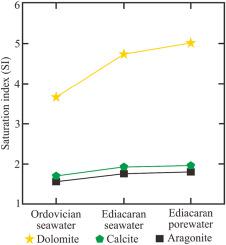Chemical Geology ( IF 3.6 ) Pub Date : 2022-08-19 , DOI: 10.1016/j.chemgeo.2022.121065 Yongjie Hu , Chunfang Cai , Ying Li , Rui Zhou , Fuchang Lu , Junfeng Hu , Chaobo Ren , Lianqi Jia , Yuanquan Zhou , Kevin Lippert , Adrian Immenhauser

|
Fibrous carbonate cement is a common phase in marine phreatic environments — but its origin and diagenetic history are underexplored. This paper compares two fibrous fabrics that are different in terms of their peculiarities but share important similarities regarding their essentials: upper Ediacaran fibrous dolomite cement and Upper Ordovician fibrous calcite cement, both from the Tarim Basin, China. The focus is on the significance of these fabrics as archives of their marine paleoenvironment. Upper Ediacaran fibrous dolomite cement is present as (i) a fascicular-optic and (ii) a radial-fibrous phase. Judging from the optical length-slow character and luminescent zones, radial-fibrous dolomite cement precipitated directly from early diagenetic marine porewater. Fascicular-optic dolomite cement has a length fast optical character and hence likely formed as a high-Mg calcite precursor penecontemporaneously in a reefal, shallow-marine diagenetic environment. Similarly, two types of Upper Ordovician fibrous cement are present: (i) radiaxial-fibrous and (ii) fascicular-optic calcite cement. Fascicular-optic calcite precipitated in a marine phreatic platform environment, whereas radiaxial-fibrous calcite cement formed in an early marine diagenetic porewater environment. Both fabrics arguably replace a magnesium calcite precursor. For the case of the Tarim Basin, cathodoluminescence and redox-sensitive elements indicate predominantly anoxic, upper Ediacaran marine waters (Ce anomaly = 0.8 ± 0.2), and suboxic, Upper Ordovician shallow-marine seawater (0.7 ± 0.2). Based on PHREEQC modeling, the shallow burial, upper Ediacaran porewater (5.1) yields a higher dolomite saturation index than upper Ediacaran (4.8) and Upper Ordovician seawater (3.7). The direct precipitation of radial-fibrous dolomite from Ediacaran porewaters was likely induced due to organic matter decomposition and related seawater oxygen depletion, elevated Mg2+/Ca2+ ratios, and high alkalinity values. Modeling and proxy data show significant hydrogeochemical differences between seawater and porewater in the upper meters of the sediment column. The upper Ediacaran seawater apparently favored fibrous cement formation with magnesium calcite precursors. In contrast, fibrous dolomite cement was directly precipitated in an early-diagenetic marine porewater regime. The comparability of proxy data reflecting seawater and such recording early diagenetic marine porewater is critically discussed.











































 京公网安备 11010802027423号
京公网安备 11010802027423号